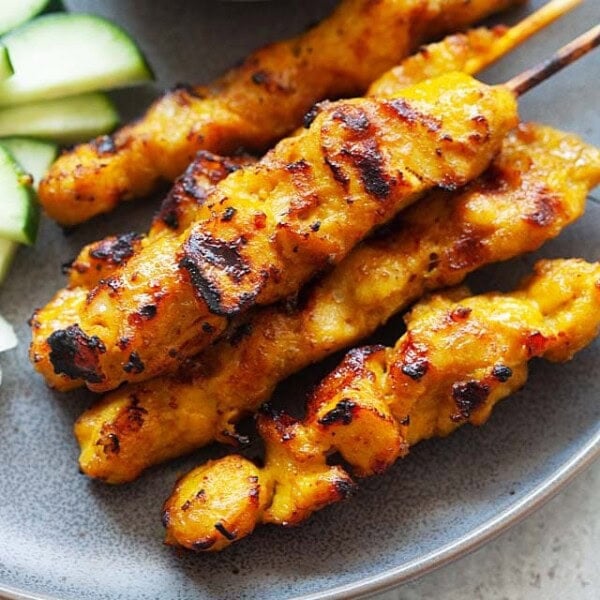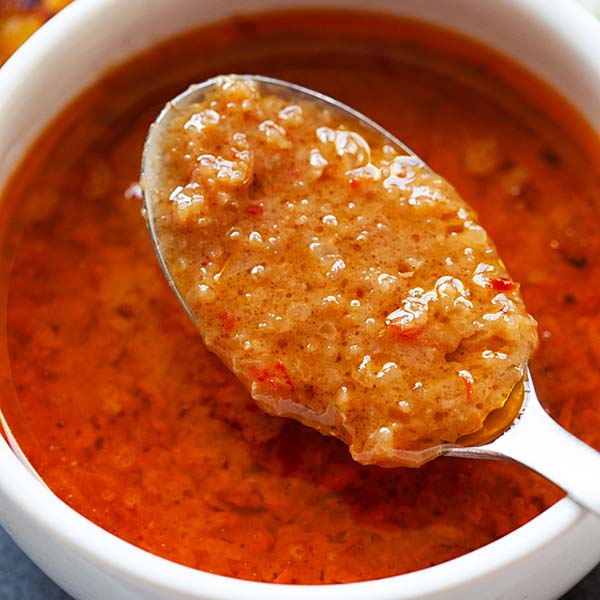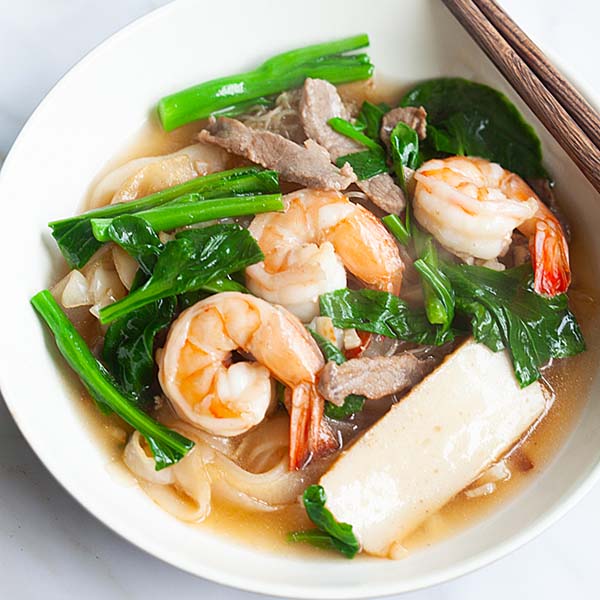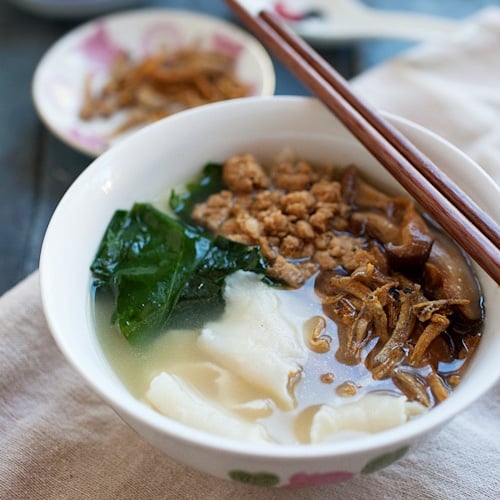This post may contain affiliate links. Please read my privacy policy.
Craving an authentic Penang Char Kuey Teow? This easy step-by-step guide will help you nail that smoky stir-fry every time. With simple ingredients and a few pro tips, you’ll bring the bold flavors of Penang right to your kitchen!
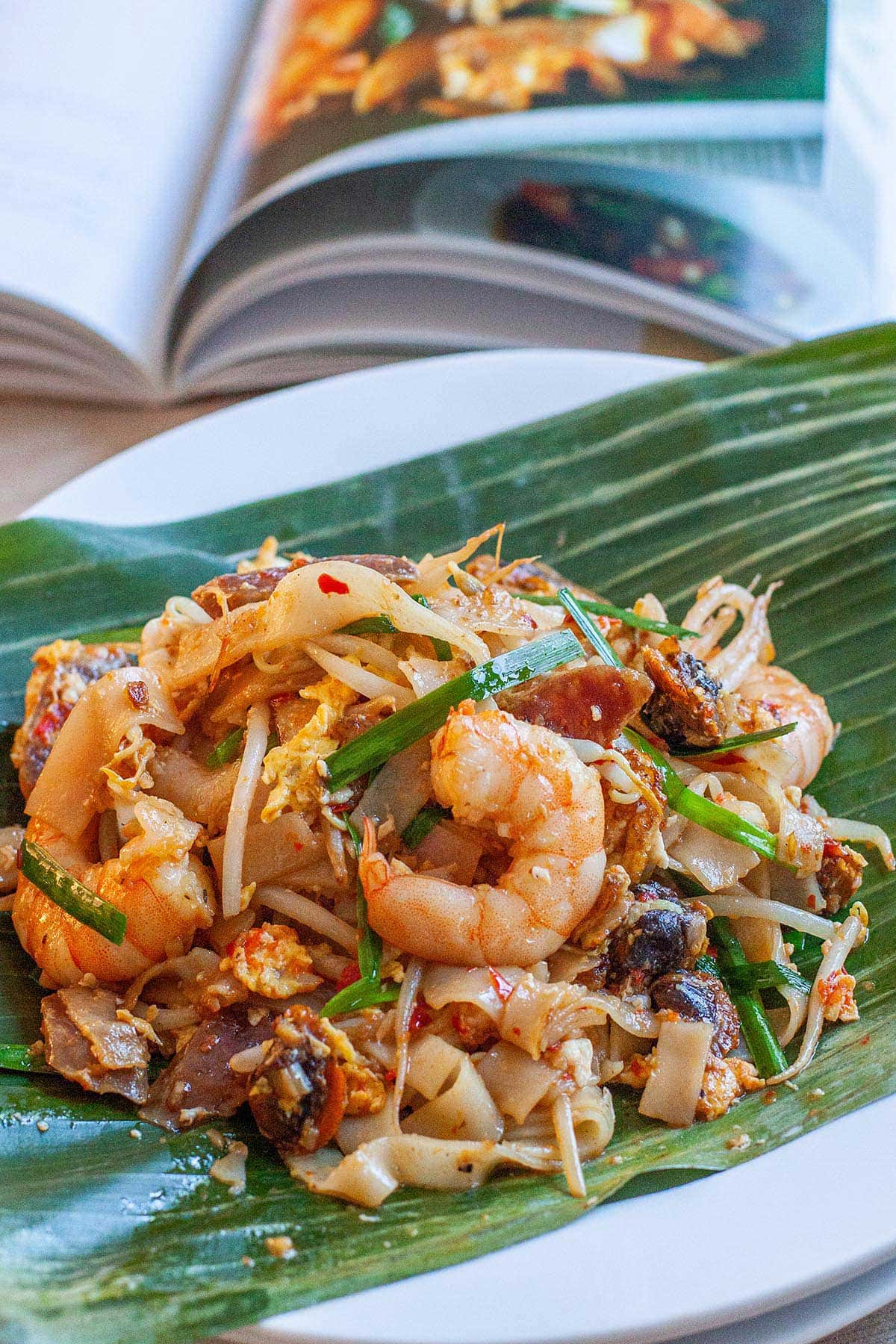
What Is Char Kuey Teow
When it comes to Penang street food, a few dishes stand out: Asam Laksa, Penang Hokkien Mee, and of course, Char Kuey Teow. It’s tough to say which one’s the most popular, but when you’re in Penang, you won’t—and definitely don’t want to—miss these three iconic hawker dishes.
Char Koay Teow is a must-try Malaysian street food, made with flat rice noodles stir-fried with shrimp, bloody cockles, Chinese lap cheong (sausage), eggs, bean sprouts, and chives, all tossed together in a savory soy sauce mix. Be sure to check out my step-by-step video and tips below to make this dish perfect every time and get that smoky, mouthwatering flavor just right!
Elements Of The Best Char Kuey Teow
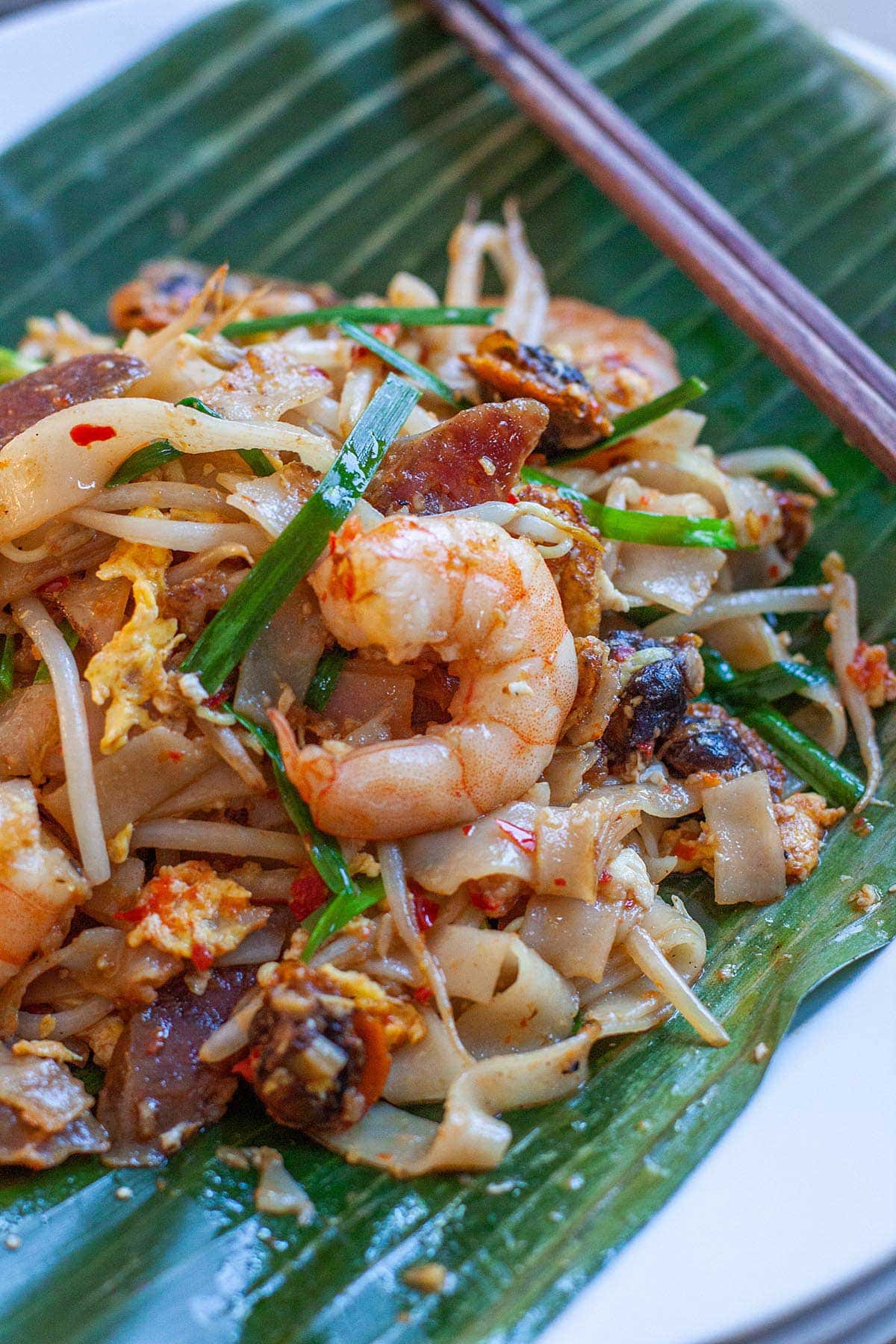
A perfect serving of this dish isn’t just about fresh ingredients—it’s the smoky, charred aroma that comes from stir-frying the noodles over high heat in a well-seasoned Chinese wok. That irresistible scent is what we call “wok hei” or the breath of the wok. If you’ve been to Penang and walked past a Char Koay Teow stall, you know exactly what I mean.
A great Char Kuey Teow calls you from blocks away; the mouthwatering aroma fills the air and pulls you in. Just thinking about it is enough to make my stomach rumble!
Penang Char Kuey Teow Reigns Supreme
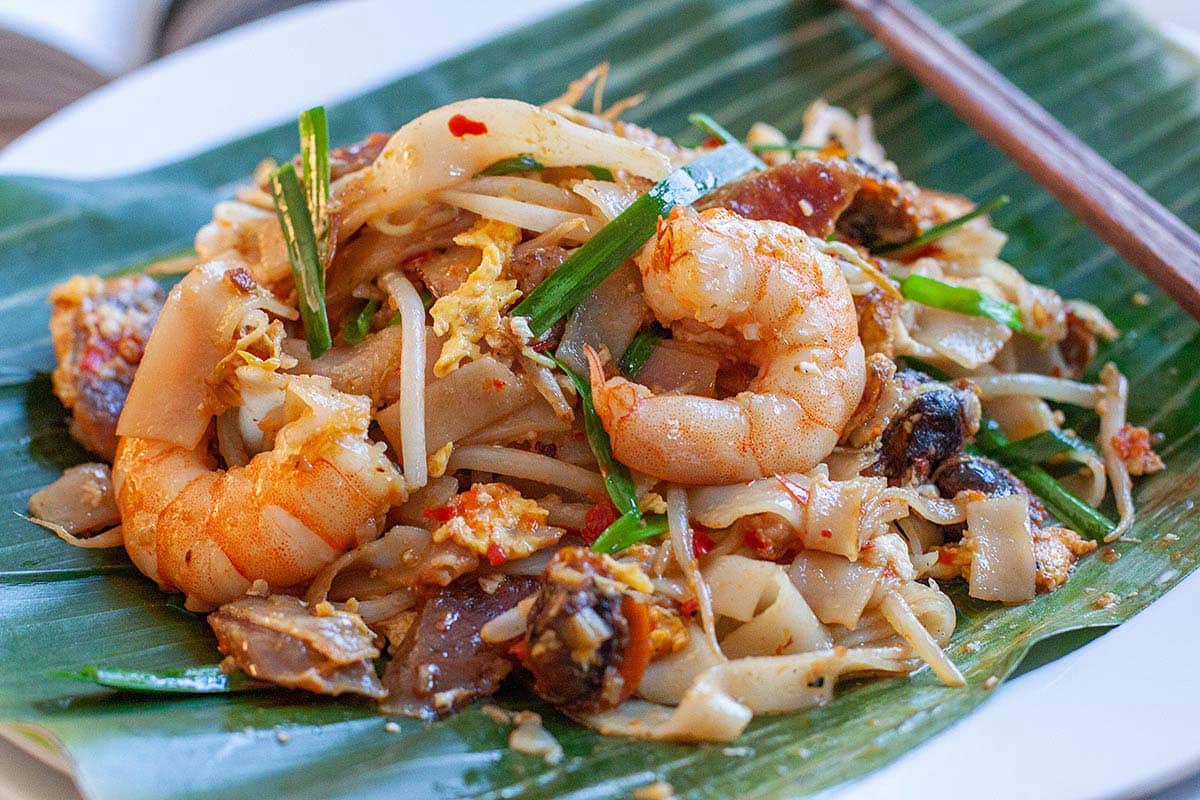
While you can find this dish all over Malaysia, the Penang version truly reigns supreme. I’ve heard countless stories of tourists from Hong Kong, Taiwan, Singapore, Australia, and beyond making the pilgrimage to Penang just to enjoy this noodle dish.
Somehow, Char Kuey Teow (or “CKT” as it’s often called) outside of Penang never quite hits the mark—whether it’s the lack of wok hei, a too-dark color, or the wrong taste and texture. That’s exactly why Malaysians from other states make the trip to Penang—just for that perfect plate of Char Koay Teow.
Ingredients You’ll Need
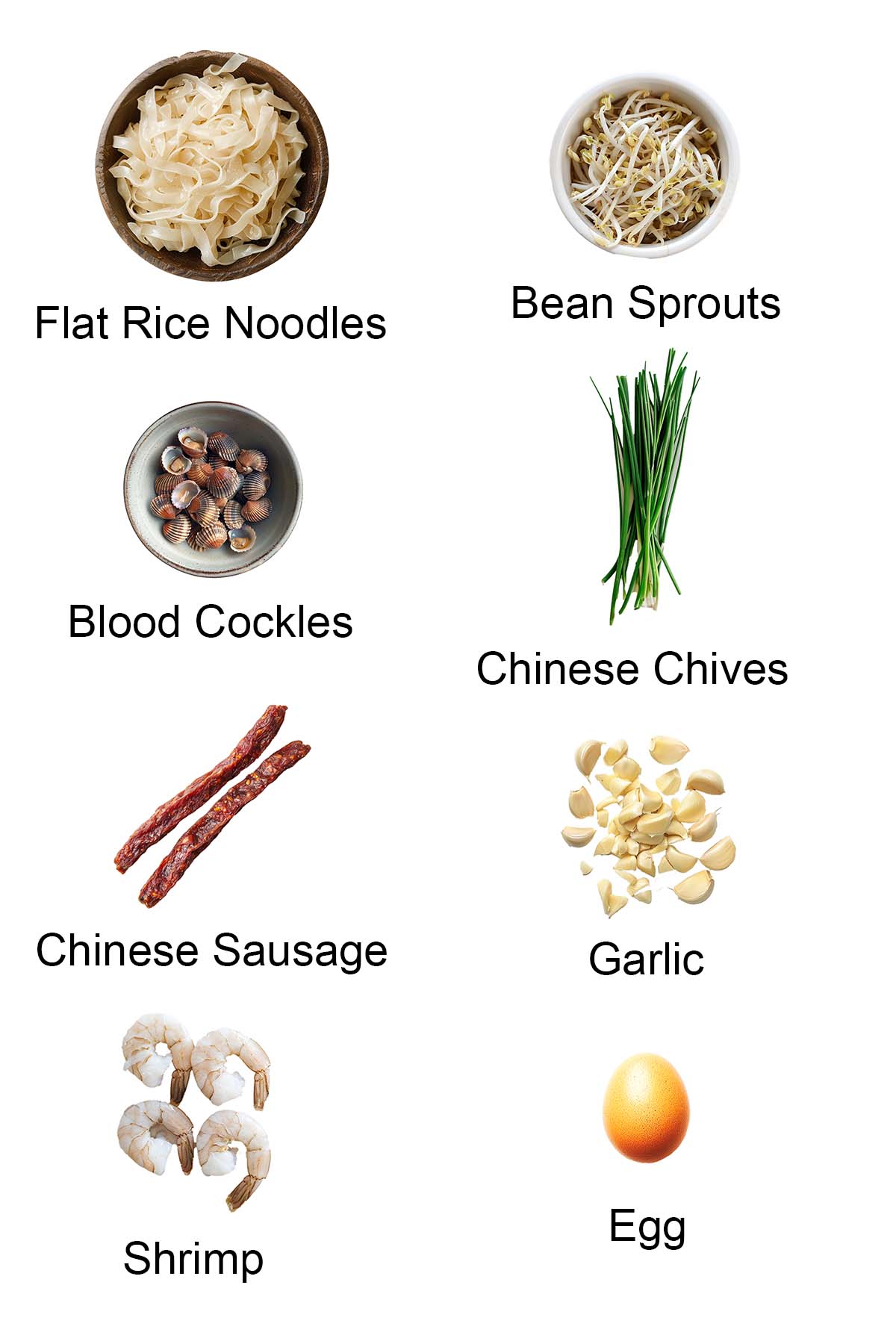
- Flat rice noodles
- Bean sprouts
- Blood cockles
- Chinese chives
- Chinese sausage
- Garlic
- Shrimp
- Egg
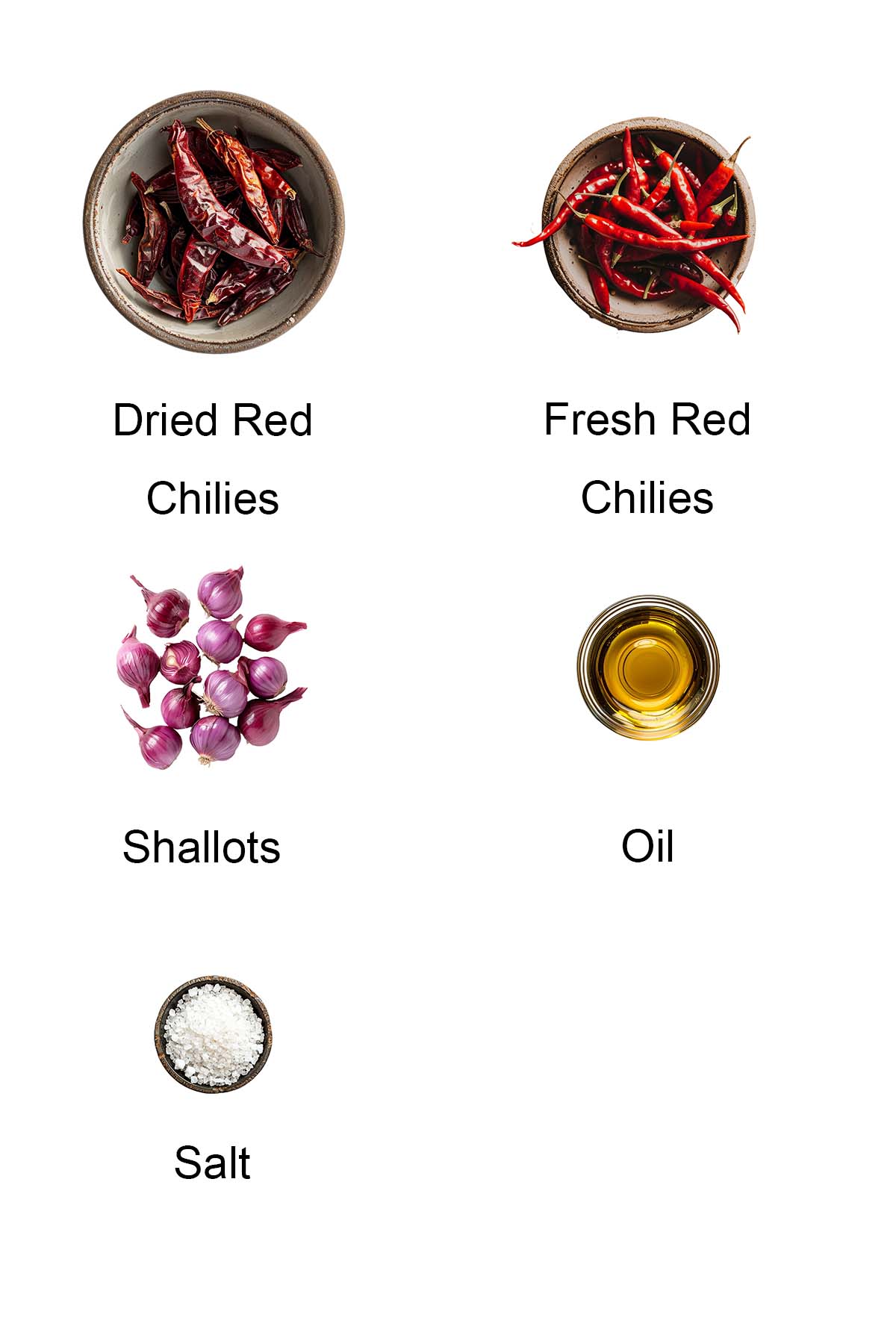
Ingredients For Chili Paste
- Dried red chilies
- Fresh red chilies
- Shallots
- Oil
- Salt

Ingredients For Sauce
- Soy sauce
- Dark soy sauce
- Fish sauce
- Sugar
- Salt
- Ground white pepper
Please refer to the recipe card at the bottom of this post for full details on each ingredient.
How To Make Char Kuey Teow
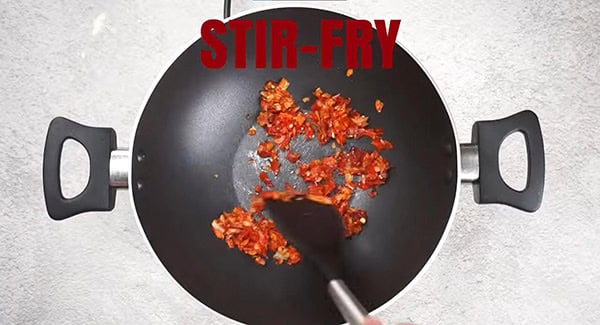
Grab a mini food processor and grind all the chili paste ingredients until they’re nice and fine. Then, heat up a wok with about a teaspoon of oil and stir-fry the chili paste until it smells amazing. Once it’s all fragrant, just dish it out and set it aside.
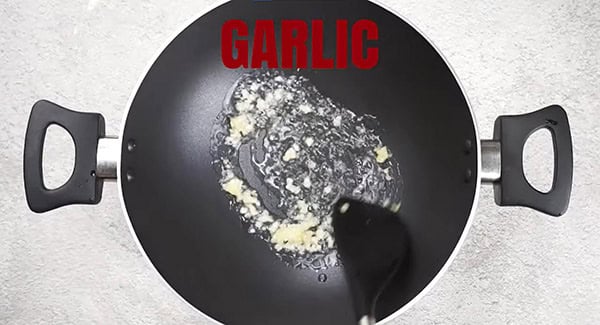
Give the wok a good clean, then heat it up over high heat until it starts smoking. Once it’s hot, add about 2 tablespoons of oil or lard, then throw in half of the chopped garlic. Stir it fast to get that garlic nice and fragrant.
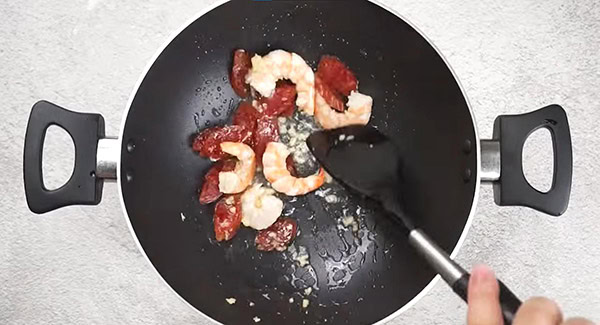
Toss in six prawns and half of the sausage slices into the wok. Give it a quick stir with your spatula until the prawns start changing color and you start smelling that delicious Chinese sausage aroma.
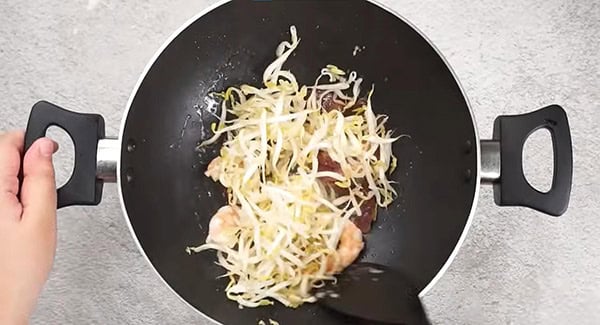
Now, throw in half of the bean sprouts into the wok.
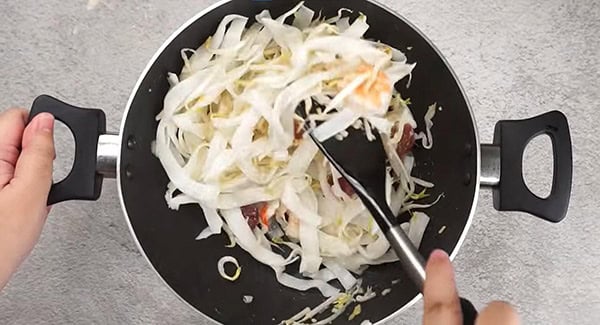
Next, toss in about 8 oz. (230g) of the flat noodles, or half of what you’ve got.
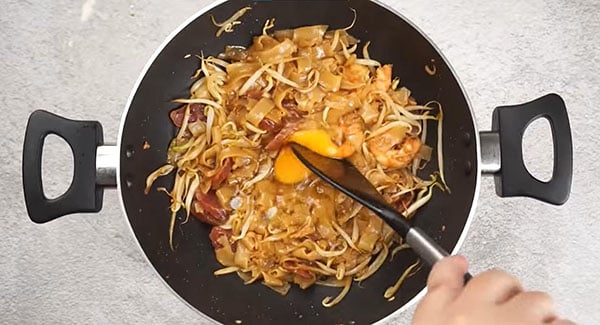
Now, pour in 2 1/2 tablespoons of the sauce and stir it all up quickly. Crack an egg right on top of the noodles, then use your spatula to break the yolk and mix it in with the whites. Flip the noodles over to cover the egg, and just let it sit for about 15 seconds.
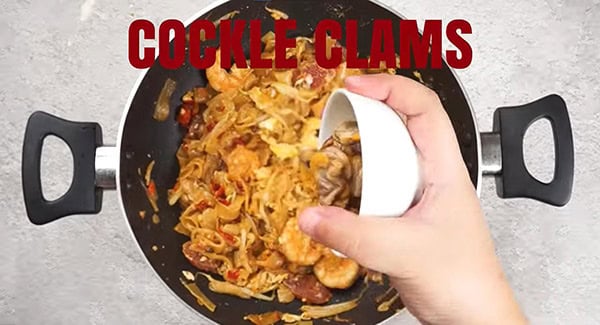
Add about 1/2 tablespoon of chili paste—feel free to add more if you’re craving extra spice—and toss in some cockle clams.
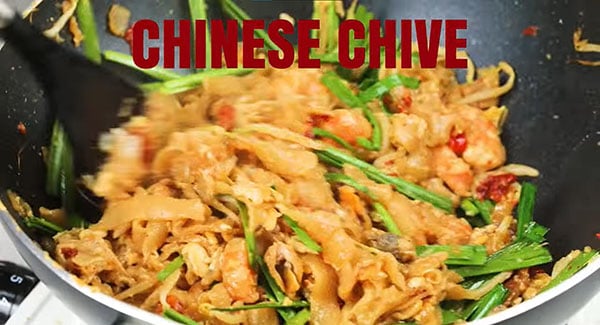
Keep stir-frying until the egg is fully cooked. Then, toss in the chives, give it a couple of quick stirs, and you’re done! Dish it out and serve right away—nothing beats it fresh!
Cooking Tips
Char Koay Teow is one the most requested recipes on Rasa Malaysia. I have readers who’ve been begging me to post my Char Koay Teow recipe since years ago.
Great things, especially a perfect recipe, is worth waiting for. Of course I’ve made Char Koay Teow many times, but I wanted to share the ultimate Char Kuey Teow recipe, and this is it.
So, what are my secrets?
- Get the freshest ingredients—fresh and crunchy bean sprouts, freshly-made noodles, big, fat, succulent shrimp/prawn, bloody cockles (I love my Char Koay Teow with them, without them, it’s not quite the same!), etc.
- Wonder why the prawn in Penang Char Koay Teow are always so succulent, juicy, and sweet? I believe some of the most famous stalls treat their prawn with sugar and ice water, or perhaps they are just very fresh.
- Use lard if you can. That’s the secret for the rich silky taste.
- Very hot wok.
- Control your timing of cooking and hence control your “wok hei.”
Frequently Asked Questions
Yes! If you’re not into cockles or can’t find them, feel free to leave them out or swap them for extra shrimp or chicken.
It can be. The dish isn’t overly spicy on its own, but it does have chili paste in it. You can easily adjust the amount depending on how much heat you want—add more if you’re craving extra spice!
This dish is best when it’s fresh, but if you’ve got leftovers, pop them in an airtight container and store them in the fridge for 1-2 days. When you’re reheating, just add a little splash of water or oil to loosen up the noodles.
This recipe is only 639 calories per serving.
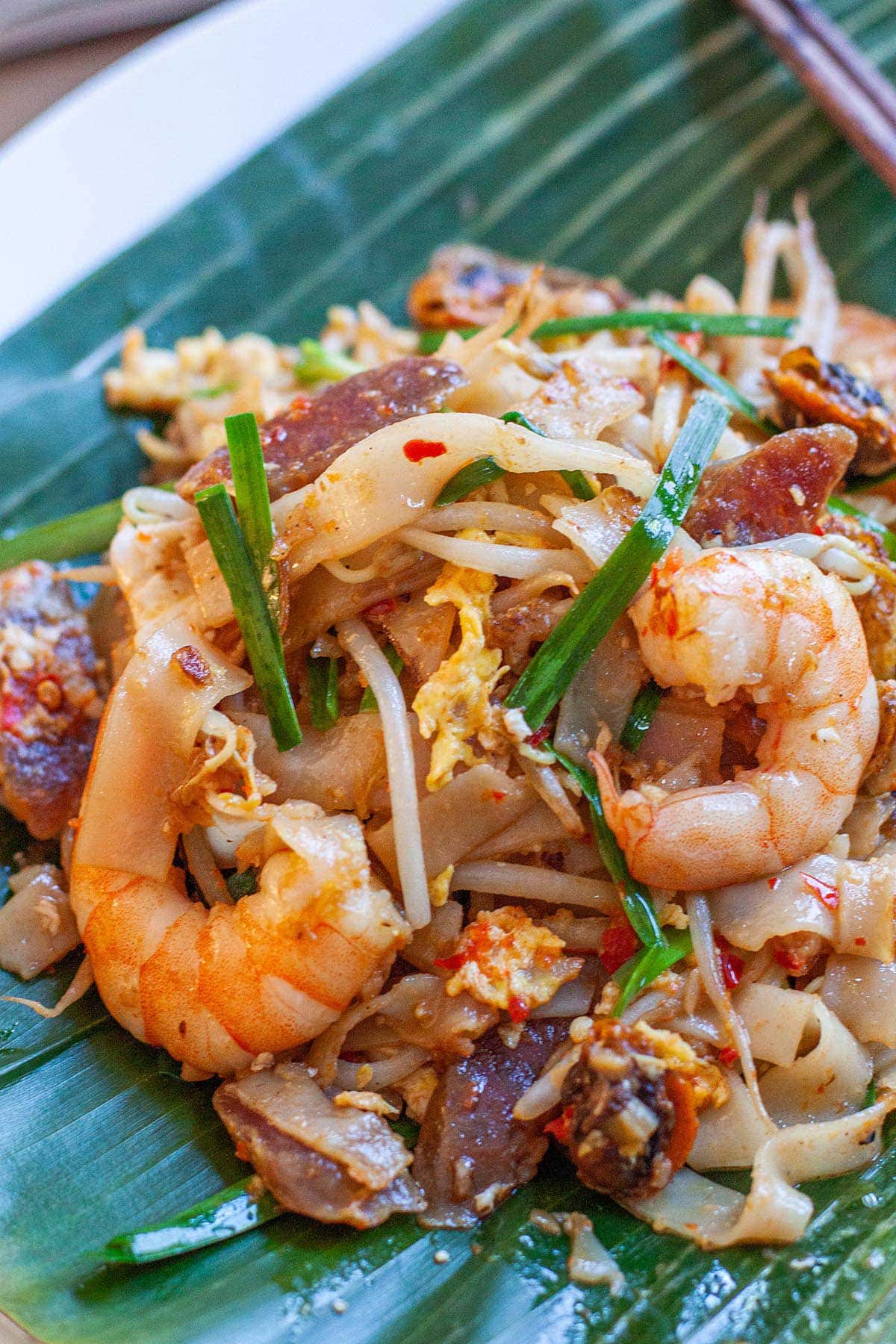
What To Serve With This Recipe
This dish is seriously scrumptious and I don’t see why it can’t be as popular and well-known as Pad Thai or Pad See Ew and the likes on the global stage.
For a complete Malaysian hawker food experience, I recommend the following recipes.
I hope you enjoy this post as much as I do. If you try my recipe, please leave a comment and consider giving it a 5-star rating. For more easy and delicious recipes, explore my Recipe Index, and stay updated by subscribing to my newsletter and following me on Facebook, Pinterest, and Instagram for new updates.
Other Recipes You Might Like
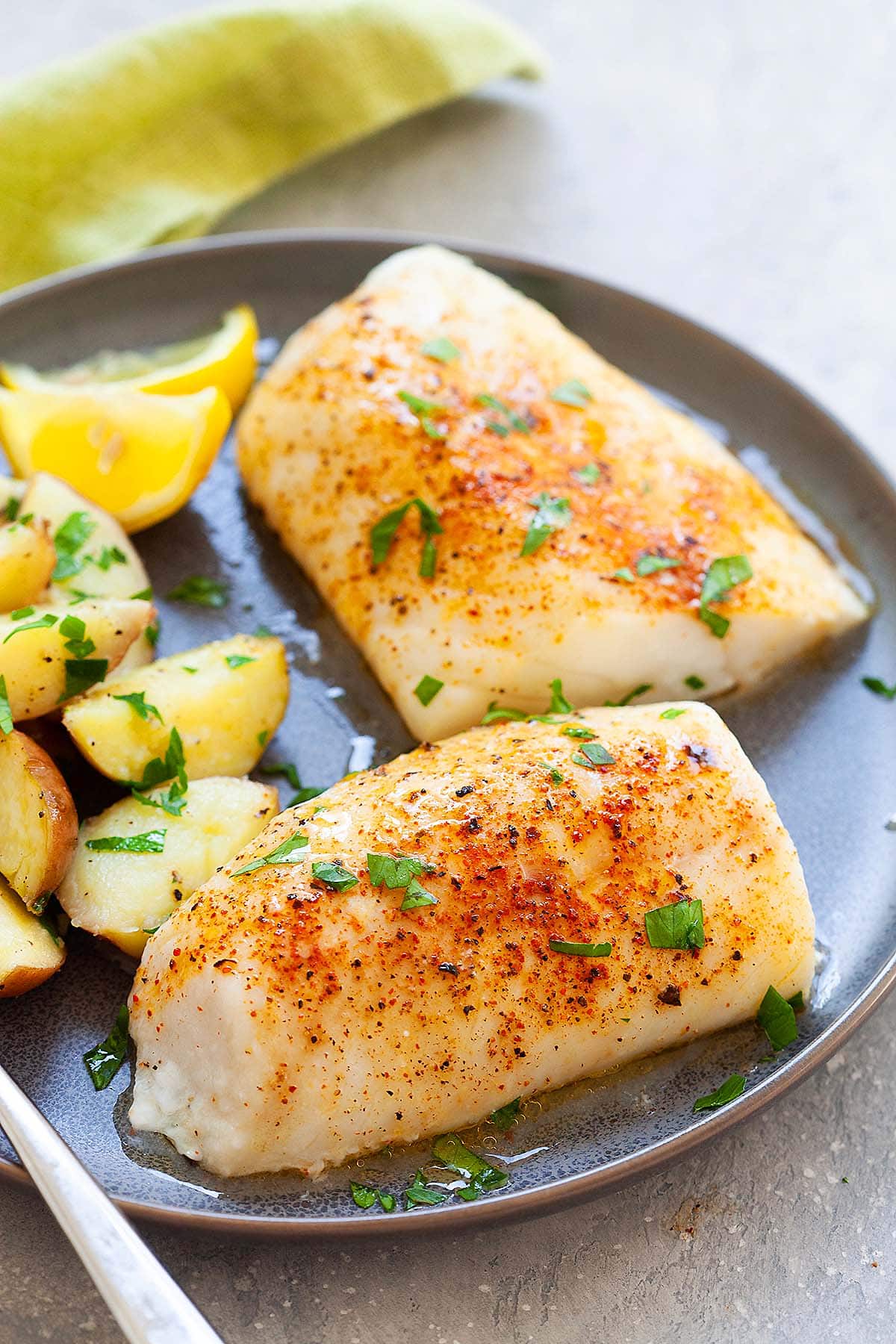
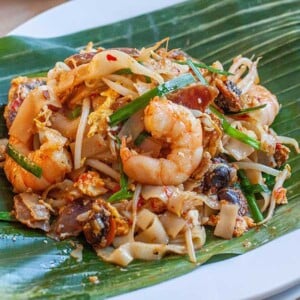
Char Kuey Teow
Ingredients
Chili Paste:
- 1 oz (30g) dried red chilies, seeded, soak in water
- 2 fresh red chilies, seeded
- 3 small shallots, or pearl onions, peeled and sliced
- 1 teaspoon oil
- 1 pinch salt
Sauce (mix and blend well):
- 5 tablespoons soy sauce
- 1 1/2 tablespoons dark soy sauce
- 1 tablespoon sugar
- 1/2 teaspoon fish sauce
- 1/2 teaspoon salt
- 2 dashes ground white pepper
Other Ingredients:
- 3 cloves garlic, chopped finely
- 12 prawn, shelled , submerge in ice cold water plus 2 tablespoons sugar for 30 minutes
- 1 lb. (500g) fresh flat rice noodles, completely loosened and no clumps
- 1 lb. (500g) blood cockles, extract the cockles by opening its shell
- 2 Chinese sausages, sliced diagonally
- 1 bunch fresh bean sprouts, rinsed with cold water and drained
- 4 large eggs
- 1 bunch Chinese chives, removed about 1-inch of the bottom section and cut into 2-inch lengths
Instructions
- Grind all the ingredients for the chili paste using a mini food processor until fine. Heat a wok with 1 teaspoon of oil and stir-fry the chili paste until aromatic. Dish out and set aside.
- Clean the wok thoroughly and heat it over high flame until it starts to smoke. Add 2 tablespoons of oil or lard to the wok, then add half of the chopped garlic and stir quickly.
- Transfer six prawns and half of the sausage slices into the wok. Stir quickly with the spatula until the prawns start to change color and you smell the aroma of the Chinese sausage.
- Add half of the bean sprouts to the wok.
- Follow immediately with 8 oz. (230g) or half of the flat noodles.
- Add 2 1/2 tablespoons of the sauce to the wok and stir vigorously to combine. Crack an egg on top of the noodles. Use the spatula to break the egg yolk and stir to mix with the egg white. Flip the noodles to cover the egg and wait for about 15 seconds.
- Add about 1/2 tablespoon of chili paste (add more if you like it spicy) and some cockle clams to the wok.
- Continue stir-frying until the egg is cooked through. Add the chives, give a couple of quick stirs, then dish out and serve immediately.
Video
Notes
- Get the freshest ingredients—fresh and crunchy bean sprouts, freshly-made noodles, big, fat, succulent shrimp/prawn, bloody cockles (I love my Char Koay Teow with them, without them, it’s not quite the same!), etc.
- Wonder why the prawn in Penang Char Koay Teow are always so succulent, juicy, and sweet? I believe some of the most famous stalls treat their prawn with sugar and ice water, or perhaps they are just very fresh.
- Use lard if you can. That’s the secret for the rich silky taste.
- Very hot wok.
- Control your timing of cooking and hence control your “wok hei.”
Nutrition
Nutrition information is automatically calculated, so should only be used as an approximation.
